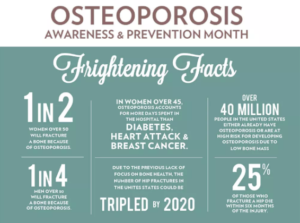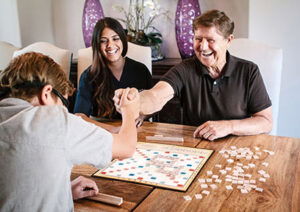Statistics tell us that each year more Americans are diagnosed with osteoporosis , a disease that decreases bone density, causing weak and brittle bones and often leading to a break. Reasons for the increase vary and may in part be attributed to the aging baby boomer demographic. Research points to 50% of women and 25% of men over 50 are likely to have the disease, and stars like Meredith Viera, Sally Field and Blythe Danner are among sufferers helping to raise awareness by sharing their diagnosis stories.
, a disease that decreases bone density, causing weak and brittle bones and often leading to a break. Reasons for the increase vary and may in part be attributed to the aging baby boomer demographic. Research points to 50% of women and 25% of men over 50 are likely to have the disease, and stars like Meredith Viera, Sally Field and Blythe Danner are among sufferers helping to raise awareness by sharing their diagnosis stories.
According to the Mayo Clinic, if bones are fragile enough, even coughing or bending over can cause a fracture, with injuries most commonly occurring in the hip, wrist, or spine. What’s more, hip fractures in 25 percent of older Americans are known to cause a decline in overall mobility and health, and in the most severe cases eventually leading to death. The end result of osteoporosis for both women and men is a higher risk of needing long-term health care, notes consumer resource outlets like LTC News.
Causes of Osteoporosis
Diet
A leading factor in osteoporosis is the American diet. Comprised largely of processed foods, what we consume in this respect lacks enough or any of the essential bone-building calcium necessary to prevent a disease that impacts one in two women and one in four men over age 50. Actually, in both men and women, peak bone mass occurs around age 30, with bone mass lost faster than it is created as we age. For women, the rate of bone loss increases even more for several years after menopause due to estrogen deficiency.
Medications and Conditions
Certain medications including long term steroid use (cortisone and prednisone), used for seizures, gastric reflux, and other conditions, can interfere with the bone-rebuilding process, as can specific medical problems including celiac disease, inflammatory bowel disease, and kidney or liver disease.
Surgery
Gastrointestinal surgery numbers to reduce stomach size for weight loss are also largely on the rise, with the procedure cited as leading to osteoporosis when the amount of surface area available to absorb nutrients—including essential calcium—is diminished.
Lifestyle
Experts find that lifestyle choices, such as excess alcohol consumption, tobacco use, and people who spend too much time sitting can impact bone density.
Genetics
Studies have shown that osteoporosis tends to run in families. If a grandparent and/or parent has suffered a broken hip from weakened bones, this increases your chances of doing the same. Once actress Blythe Danner was diagnosed, her daughter and actress Gwyneth Paltrow found out she has osteopenia—a precursor to osteoporosis—after suffering a leg fracture at age 37.
Signs and Symptoms of Osteoporosis
In early stages, osteoporosis is typically without indication. Once weakening has occurred, signs and symptoms may include back pain caused by a compressed or fractured vertebra. Loss of height, stooped posture, or a bone that breaks much more easily are also signs of the disease. Shortness of breath from smaller lung capacity due to compressed disks can also occur.
Actions to Stem the Tide of Bone Loss
Diet
A calcium-rich diet that includes low fat dairy products, dark green leafy vegetables, canned salmon or sardines with bones, soy products such as tofu, and calcium-fortified cereals and orange juice, is a necessary component of healthy bones.
Exercise
Not enough can be said about the benefits of exercise—both strength training and cardio—especially as we age. Experts believe any weight-bearing exercise that improves balance and encourages good posture can help mitigate the loss of bone mass. With weightlifting high on the agenda, walking, running, stair climbing, power yoga, hiking, jogging, tennis, jumping (nothing like a jump rope workout!), and dancing are also considered beneficial.
Calcium
Men and women between the ages of 18 and 49 need 1,000 milligrams of calcium a day. The daily amount increases to 1,200 milligrams when women turn 50 and men turn 70. As stated above, reliable sources of calcium include low fat dairy products, dark green leafy vegetables, canned salmon or sardines with bones, soy products such as tofu, and calcium-fortified cereals and orange juice.
Calcium supplements are recommended if it is difficult to get enough calcium from your diet. The caveat is that too much calcium, particularly from supplements, has been linked to kidney stones, with some research suggesting it can also increase the risk of heart disease.
Vitamin D
Most people need at least 600 international units (IU) of vitamin D per day before age 70, increasing to 800 IU afterward.
Known to improve the body’s ability to absorb calcium, vitamin D is often acquired through sunlight. If you live in northern climes and especially the Northeast where gray, wintery weather can last five to six months of the year, or if you are housebound or try to avoid the sun and routinely use sunscreen as people are directed to do, this can interfere with sufficient vitamin D intake. Food sources to help ramp up your intake include trout, salmon, and some types of milk and cereal fortified with vitamin D.
Supplements are recommended if not getting enough from sun or diet, which bloodwork generally done as part of a routine physical can reveal. Multivitamin products contain between 600 and 800 IU of vitamin D (check label), with up to 4,000 IU of vitamin D per day safe for most people.
Bone Density Test
After age 50, a recommended bone density test can help determine if you are losing bone mass. Typically taking under 20 minutes, the test uses low-dose X-ray to measure how many grams of calcium and other bone minerals are contained in a bone segment. Most commonly tested bones include those in the spine, hip, and forearm. The first test, known as a baseline, will be used for comparison with a follow up every one to two years, or according to your healthcare provider.
Final Analysis
In addition to monitoring the state of bone density and maintaining a healthy lifestyle, including the right diet and exercise to promote bone health, if osteoporosis is progressing your healthcare provider may prescribe medication. This usually takes the form of bisphosphonates, such as alendronate (Fosamax), risedronate (Actonel), or ibandronate (Boniva). With that, the best medicine is always prevention, i.e., disease awareness and taking an early course of action to prevent it. Medical professionals concur that taking measures to prevent the increasingly common age-related disease of osteoporosis should be a year-round effort.
“Osteoporosis: A Silent Destroyer of Senior Overall Health,” written by Beth Herman, Amada blog contributor.















